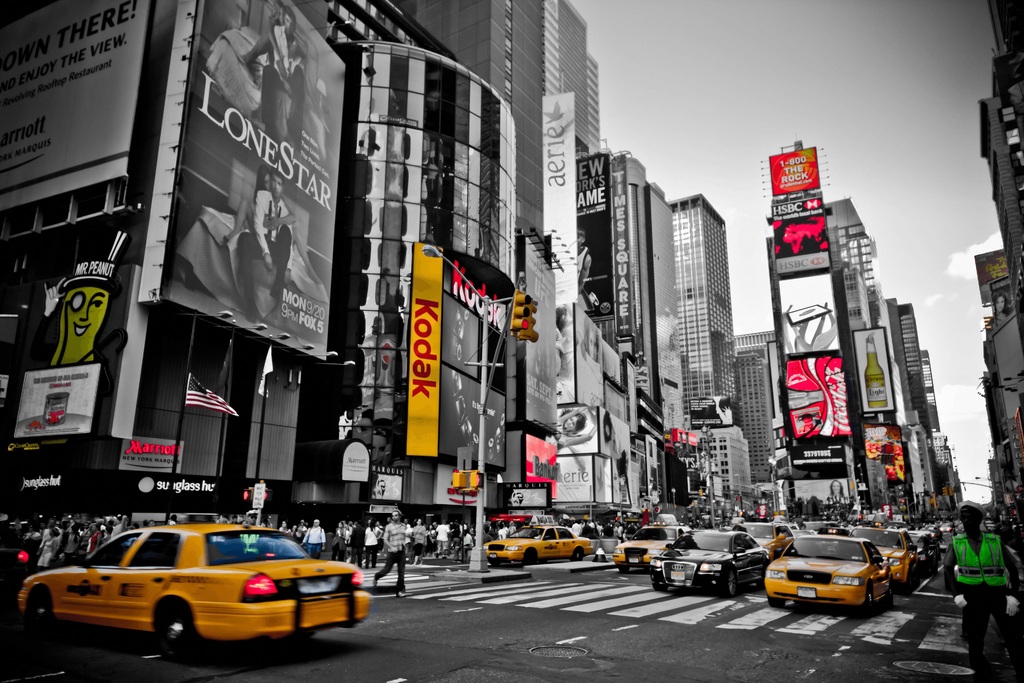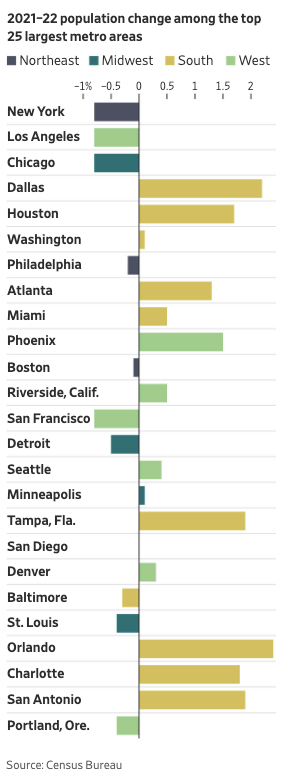Exodus from Big Cities?
People are leaving our cities for the suburbs. But not on an equal basis.

Our old friend Dave Schuler calls balderdash on the WSJ report headlined “Exodus From America’s Big Cities Slowed Last Year.” Reading that title and the intro
Big cities lost fewer residents last year as more immigrants moved in, fewer people died and more babies were born there, according to new census data that shows the urban exodus that gained steam early in the pandemic is cooling.
one would indeed be misled as to what’s happening. Observes Dave:
That’s one way to look at it. The other way to look at it are that New York, Los Angeles, and Chicago are losing population while Dallas, Houston, and Atlanta are gaining population. Another way to look at it is that metro areas in Red States are gaining population while metro areas in Blue States are losing population. In fairness Seattle, Denver, and Riverside did gain a little population. Of the twenty-five largest cities in the country no city in the Northeast or Midwest gained population last year.
Looking at the graphic in the report, that definitely stands out:

Digging into the report itself, though, it takes a long time to get there because it focuses on macro-level trends:
The suburbs of big cities and small and medium-size metropolitan areas continued to claim most of the country’s growth, according to a Wall Street Journal analysis of population estimates released Thursday for the year that ended June 30. Rural areas and small towns collectively remained nearly flat.
The core counties of large metro areas had an estimated net loss of more than 800,000 movers to the rest of the country, but that was an improvement from a 1.2 million drop in the preceding year, the Journal analysis shows.
After a sharp falloff in immigration at the peak of the pandemic, the latest data shows a revival that has helped bolster large urban counties, with about 500,000 net arrivals from abroad last year. A rise in births and fewer deaths also helped offset moves out of urban counties, leaving their collective population little changed for the year.
The given explanation
The pandemic spurred a burst of mobility—some temporary and some potentially permanent—that accelerated pre-existing trends on where and how Americans live. Suburban areas have emerged as the clearest winners, often gaining at the expense of the core city they encircle.
The changes that are taking hold have prompted cities to consider converting office buildings to housing and to rethink mass transit service that has lost many commuters between suburbs and downtowns. Bank regulators and investors are rethinking commercial real-estate investments as some office landlords default and some rents drop.
[…]
“Tech workers, bankers and managers in big cities are finding they are now only going into work three days a week and are happy to have an extra 20- or 30-minute commute for more space,” Mr. Bloom said. “The prices of properties in the suburbs of big cities have gone up a lot.”
Chris Porter, chief demographer at John Burns Real Estate Consulting in Irvine, Calif., said that in the wake of the pandemic suburban areas are likely to continue to be growth areas for employment and far outer-ring exurban areas are likely to see more housing growth. “That’s where the land is available and you are seeing a lot of construction,” he said.
certainly seems plausible and comports with other reporting we’ve seen over the past three years. Central cities can be great places to live if you’re either 1) young and single or 2) rich. Otherwise, people with families tend to want more space—and a yard!—that is unattainable to all but the most affluent in our oldest cities. And, rather obviously, if you can get big city wages and live somewhere else by telecommuting, the incentive for living in the city center diminishes further.
None of that explains the fact that the losing cities are almost exclusively blue and the gaining ones red. The WSJ report doesn’t really try.
The New York metro area, the nation’s most populated, saw its population decline 0.8% in the most recent year’s data. The second- and third-biggest metro areas, Los Angeles and Chicago, saw similar percentage declines.
While suburbs grew collectively, some suburban counties in the biggest areas shrank, including Los Angeles, Chicago and Washington, D.C.
Ten of the country’s 25 largest metropolitan areas lost population during the one-year period. The gainers were all in the South or West, with the exception of the Minneapolis-St. Paul area, which recorded a small gain after losing residents the year before.
Collectively, the populations of suburban counties and small and midsize cities increased 0.7% during the year. The search for more affordable housing is attracting many to these areas.
Dave’s take:
I suspect that jobs, taxes, and affordable housing which are interrelated are all factors in the change. Some would say climate but I’ve been to Phoenix. It has a lousy climate—almost unlivable without air conditioning. I would say the same of many of the cities that are gaining in population.
There has been a general migration from the “Rust Belt” to the “Sun Belt” going on as long as I’ve paid attention to such things. Newer cities aren’t really “cities” at all in the way I tend to think of them; they’re really more concentrated suburbs.






First off, this quote from Dave Schuler is wrong based on the included chart.
“Of the twenty-five largest cities in the country *no* city in the Northeast or Midwest gained population last year.” (emphasis in original)
Minneapolis did gain.
Second, why blue are losing and red are gaining?? Lower housing costs plus sun seem to make up the bulk of the reason. We will see how long this lasts as heat, water issues, storms, flooding, road congestion and red state overreach start taking their toll on these southern cities.
Third. These aren’t really red cities. They are in red states but Houston, for example, is very, very blue. With the latest very red Texas laws limiting women’s rights, for example, there may be a change in migration patterns to blue cities in red states.
I would suggest the loss of population in blue cities is the result of housing costs and the fact that development of new housing is limited by available land, Nimbyism and the fact there is no market imperative for developers to build moderate priced housing in those cities. Blue coastal cities are land locked, cities like Houston can expand by taking over a surrounding unincorporated area. This expansion results in sufficient land that it makes sense to develop moderate priced housing.
Also there is a shrinkage of housing in cities like Boston in NY that eliminates even more moderate income housing. Multi-family housing is torn down to be replaced by a building that may be about the same overall size, but has fewer, but larger and more expensive apartments.
Cities are also great places for seniors, since you have most of your typical daily needs nearby and have transportation options. We’re in a suburb that is fine for now, but it lacks any type of reliable public transportation, even taxis are scarce. It’s fine for now, but a point will come when we’ll want to jettison the house and when I look at options, there aren’t many that are walkable neighborhoods.
What immediately strikes me is that Dallas is one of the growth areas. The Dallas metro area is one sprawling suburbia in ways that NYC isn’t (ditto Houston). So, I wonder about the categories (or, at least, the comparability of the metro areas)
There is a lot of land for places like Dallas and San Antonio to grow into (and I would bet, for example, that the growth in Dallas is to the north). There isn’t land for NYC and LA to grow into. This affects real estate availability and prices.
I am not saying I am necessarily right, but it seems that there needs to be a deeper inquiry as to comparability (or, at least, making clear why conditions might be different, which, again, affects the cost of living).
I’m surprised the WSJ didn’t clarify that the moves are OBVIOUSLY happening because of people wanting to move to FREEDOM and LOWER/NO STATE TAXES (No one talks about local fees needed to support services).
I love urban life. I love the hustle and bustle, the vibe and bright lights. But I understand that living in a city makes less sense than it once did. Cities exist because they are centers of commerce and safety. However, work from home and e-commerce makes it very feasible to live outside an urban concentration. Electronic media even allow romantic hookups without having to physically cruise bars and other venues to meet someone for a night or a lifetime. You don’t have to live inside the walls of the city to be safe from marauders, and there is the perception that cities contain lawlessness (there seem to be plenty of fentanyl ODs and shootings in our rural states). Throw in cost of housing and the total experience of urban life is less desirable. I don’t like it, but I acknowledge it.
People have been moving to warmer places for a long time. With air conditioning really hot weather doesnt matter that much. The important part is that you are missing the snow and not having to deal with it. (Ask Jax) The next factor is housing costs. Some of that is NIMBY stuff but the cities losing people are old, not so much for the ones gaining people. Older cities have geography limitations. It can be addressed but its not easy. In the newer, wide open cities its not an issue, much. Next, I think, is cost of living. Places like NYC and San Francisco have successfully attracted and developed high end businesses so they have a lot fo high income people concentrated into smaller spaces which drives up prices.
Part of that is taxes if we are honest but that does get tricky. WalletHub did its own analysis of tax rates recently. Just using Texas as an example, it doesnt have an income tax but it has lots of other regressive taxes. So if you are well over the median in income you really do pay less in taxes but otherwise your total tax rate is pretty high. Freedom? If you equate freedom with privilege than you probably are better off in those cities if you are male and making a decent income. If you are female or “different” in any number of ways too long to list then you probably face a loss of freedom.
Steve
@Slugger: One thing that is a positive about big cities for my demographic (age greater than 75) is access to medical care. High quality medical facilities are simply more available in the big cities. I have several friends who have settled in big cities after having spent time in rural or even expatriate settings because of medical issues. Cardiac electrophysiologists are just not available in Green Acres settings.
The more interesting shift to me is that one source I read recently noted that more people of limited income are moving to the suburbs. This may become important in the future in that the suburbs were originally intended to be places where people of median and higher incomes came to escape the problems of having to live in mixed communities with lower income people in them.
A cruel irony at best, but a significant emerging problem if the trend continues.
@Steven L. Taylor: Exactly. It’s what I was getting at when I wrote “Newer cities aren’t really ‘cities’ at all in the way I tend to think of them; they’re really more concentrated suburbs.” Dallas and Houston have a lot going for them but they’re simply different things than NYC or Philly.
My youtube feed recently got piled up with local news videos from Hawaii on the loss of population in paradise. Some report from the state economist coming out. Losing 20 people a day to CA, WA, AZ, TX, and FL. High cost of living and, apparently, some continuing pandemic restrictions are cited as the reasons.
This is written in the context of middle class women gaining freedom from the home in the 1920s, but the observation on how housing in cities was mostly just bases for the larger fun is on point. But those small urban living spaces became a problem when leaving home was banned and now with rampant street crime.
Add that to the bulge of the Boomers are now moving into or planning their retirements with the pandemic spurring movements that may have been spread over a longer period without it.
Hypothesis for the red/blue state city divide:
A lot of the blue state cities are part of larger conurbations, mostly notably the Northeast Megalopolis, that make it possible to live a cosmopolitanism life outside of the official bounds of the cities (I live about 1.5 hours outside of Philadelphia and my area is still a heavily Democratic urban area)
Meanwhile in red states, increasingly restrictive governments are forcing people back into cities to maintain a cosmopolitan life. If you’re 1.5 hours outside Houston, you’re in hard core MAGA country.
The trend of people moving to the suburbs from cities and rural areas is long-standing, and now well over half the US population lives in suburbs.
Secondly, the problem with these comparisons is that there are multiple factors in play, there aren’t neat dividing lines between a core city and nearby suburbs, metro areas are statistical creations and are generally very diverse due to history, local geography, etc.
Then there is the reason(s) people may move, which can be job, cost of living, weather, family, lifestyle, age, or any number of other reasons. Cost of living and jobs are probably the biggest factors.
And yes, the west and the south are growing compared to older cities, and they simply have more comparative advantages across these factors, especially the cost of living and quality of life.
Just me personally, I love NYC and California but not enough to take the income hit to live there, and most of the places I’d like to be are simply not affordable, even on our upper-middle-class income. Plus, I’m in Colorado because it’s where I’m from, and I’m the Guardian of my sister, who is institutionalized with dementia. And even here, we are lucky we moved when we did – housing prices in our area have gone up 40% since 2018 – if we moved here today, we couldn’t afford it.
We also have relatives in Detroit; you can buy a house there for pennies. The reasons that NYC is not growing are very different than the reasons Detroit isn’t growing. NYC has expensive housing and hasn’t been able to expand housing supply, leading to astronomical prices. My sister-in-law, who is in the fashion industry, had to move out of Brooklyn thanks to increasing rents, then was laid off during Covid and eventually got a fashion job in another state and doesn’t plan to return to NYC.
By contrast, Detroit doesn’t have the jobs and so housing and cost-of-living are at the other end of the spectrum. The kids of our relatives who live there have mostly moved to other parts of the country because there just aren’t many opportunities there.
So, anyway, I’m skeptical that we can make accurate predictions about the “why” behind large statistical trends.
@JKB: “now with rampant street crime.”
You’ll just believe anything Fox tells you.
“Losing 20 people a day to CA, WA, AZ, TX, and FL. ”
Wait — Hawaii is losing 20 people a day? That’s almost 7500 people a year!!! Hawaii’s only got a population of a million and a half — at this rate they’re going to be completely screwed in two hundred years.
@Sleeping Dog: @Steven L. Taylor: Both of you make good points. I’ve long been frustrated by the shallow thinking inherent with judging the health of a city solely by population growth or decline. As Steven points out, older cities are built out and have been for a century or more. There is no inexpensive farmland or virgin empty lots waiting to have 3000 units built in 18 months. What land has become available due to declining manufacturing is highly problematic. So the fact that a relatively fixed number of housing units accommodate households with fewer people may explain a lot of this. For example, Baltimore had a population of 950K in 1950. It is 580K now, a reduction of 40%. But, from then until now the average household size declined from 3.4 to 2.3. That alone would account for a 30% decline in population. I wonder how much that remaining 10% could be explained by the knocking down of thousands of housing units to build I-83, I-95, I-396 and, a half a dozen other highways, with all their interchanges and ramps?
Other factors are involved too. Sure, If I drove around some of the tougher sections of the city over the past 50 years, I would see more and more houses and row houses boarded up and even knocked down. Even in the South Baltimore neighborhood I’m living in now, I would also see a decline in number of row houses (no freestanding houses here), but for a different reason: when the stock was cheap more than a few people bought two units side by side and turned them into a single unit. And more than a few developers were able to buy multiple units, knock them down and build bigger units with first floor garages. But now that’s a thing of the past. In fact, the 3 bedroom rowhouse across the street from us just went for $675K. So very few units are getting combined nowadays. In fact, I’m pretty sure we are gaining units and population in my specific area as more and more warehouses and businesses are getting knocked down and 200-500 unit apartment complexes built in their places. But this type of growth is limited in where it can occur, because in the sections of the city with free standing houses they are fighting to the death over any zoning changes that would let in any multi-unit building.
My point is that population size means very little when it comes to the health of an older city. Households are smaller. Even single people are looking for two and three bedroom units with big living rooms and kitchens. My part of Baltimore feels alive and dynamic and growing, while Baltimore County (the near-in suburbs) feels like it is winding down and, yes, even decaying in spots.
Without details like “where are people moving from?” and some effort to correct for lot size, it’s pretty hard to understand these trends. You can come up with any explanation from “the Democrats in red states are huddling together for safety” to “people want to live in sprawl with yards and exactly X density”.
If the populations of cities in barely red states are growing faster than the populations of the states, then @JKB’s uninformed crowing will be short lived*. Georgia is already a swing state, and Texas is perpetually on the verge.
*: although given that his reading list is over a hundred years out of date, he might not notice.
I suspect that within 20 years we’ll see a complete reverse, with people stampeding out of states like Arizona, New Mexico, and Texas for one single reason: water.
Illinois may have problems, but at least we’re sitting next to one of the largest sources of unsalted fresh water in the world. And Florida is going to find itself under sea level pretty quickly if global warming keeps on. So much for Grandma and Grandpa and all the golf they were expecting to get in.
@grumpy realist:
It won’t take that long. And don’t forget about heat.
“Look at all the people who are moving here.” That may be a useful line for politicians, but not so much for the quality of life in a city, region, or state.
When I was growing up in the Bay Area, the population was half of what it is now, and it was a wonderful place to live. Now there are too many people and cars, houses jammed together, etc. Developers seldom care about quality of life issues, they just want to build, get paid, and build some more.
Life can still be very good here if you have some money to insulate yourself, but I can’t imagine being young and trying to get established. It’s a very steep mountain to climb.
So, some people are leaving. That’s OK, we have far too many people living here now.
It’s not really mysterious: if some places get really expensive to live in, people will, despite the countervailing attractions of the location, start looking at other places.
Europe is a bit different, given much tighter development controls, and differences re. car travel practicality, so not suburban mega-sprawls so much.
But on the anecdata side, I have two nephews and a junior cousin who’ve recently married and decided to move out of London.
They (and their partners) all advanced enough in their careers to move to reasonably paying positions in provincial towns, where they can actually afford a house in a nice area, rather than one-bedroom flats. The price differential is HUGE.
London is becoming very stratified: upper tier professionals, people who have inherited property, young people living with their parents (now including young marrieds doing so), incoming “strivers”, and also the “precariat” in more run-down areas.
Conitental European cities are worth looking at for a contrasting approach: far more in social housing or in rented apartments which are in long term trusts. Unlike UK rentals, they are not looking to pay a mortgage and make a profit on top, making them more expensive than buying the property.
Instead, a lot paid off the base costs decades (or centuries!) ago, and only need to charge enough to maintain and make a decent return. Which they can, easily, within controlled rent limits.
See Vienna:
Few people consider Vienna to be a run down socialist hell-hole.
I would rather eat hot broken glass than live in the suburbs. Besides the issues of water and climate change, a lot of the Neo-Confederacy is going to start bleeding Queer people, Doctors and college educated women. Once they get done criminalizing those three groups, they’ll start in on everyone else.
@grumpy realist:
Hey just wait, if that schmuck Vallas wins we’ll have rampant street crime: caused by the lawless MAGA cops he’ll hire to kill fags and blacks…
@Andy:
I live in Fort Collins at the north end of the Front Range urban corridor. Population is now 180,000. Within two miles of me there are >12,000 approved new housing units, ranging from apartments to condos to townhouses to single family houses. Unless everyone is wrong, that’s another 30,000 or so people — 17% growth — that’s going to happen over the next five years.
@JohnSF:
Depending on the exigencies of career, we plan to relocate either to Barcelona or Lisbon. Not terribly original choices, but very serviceable.
My entire life could be summarized as, ‘trying to get back to France.’ Years 7-10 I lived in a French village, attended school in a small city, and it left a mark. The places in the US that I still have some enduring affection for all mimic aspects of European life, from Austin’s strip to Portland’s Old Port, to the Minneapolis skyways, to my neighborhood shops in Evanston.
If there’s a single memory I fixate on, it’s riding my bike from Place Carnot in Fouras, down to the boulangerie to pick up a baguette or a grand pain, so fresh they were too hot to hold onto. It’s not the same in a car. Especially when it’s 25 minutes through traffic. And you have to tip the valet $5.00.
@Michael Cain:
Is the road system being built out to support all the new traffic that this growth will create? Out here, developers got very good at presenting a “don’t worry, be happy” approach to questions about the effects of development. Do that for long enough and you end up with a gridlock mess you will never get out of.
@grumpy realist:
One of the things the computer models still don’t handle well is the North American Monsoon. Stronger monsoons could have significant moderating effects in Arizona and New Mexico.
@anjin-san:..I left my Heart… (sometimes I think that I left my brains there too)
My time in the Bay Area was the year that I lived in San Francisco ending in June of 1975. My main employment was working as a live in personal attendant for my disabled friend Joe. We were able to afford a two bedroom not so old apartment in a building at the northwest corner of Irving Street and Funston (should have been named 13th Avenue) in the Inner Sunset. Even then San Francisco was touted as one of the more expensive cities in the country to live in. Can’t remember what the rent was 48 years ago but between the benefits he received for being 90% disabled (That meant he could feed himself if I cut the food up. If I would have had to spoon feed him he would have been 95% disabled. 100% disabled means you are totally fucked.) and what the county paid me for doing the things for him that he could not do for himself we had enough money to keep us in cheap beer and weed til the next assistance check came.
After I returned to the midwest Joe lived in The City for almost 20 years. I visited him there many times and often wondered what my life would have been like if I had stayed there too.
Even when I was living there single family homes were being bought and torn down and replaced with three unit apartments where zoning allowed it.
If I was a smart guy I would have done that in 1975 and would now be sitting on a pot ‘o gold!
@Michael Cain:
Ft Collins is nice, my niece lives there and we go visit occasionally and also go tasting at New Belgium – my favorite brewery. Ft. Collins was on our short list when we moved back to Colorado, but ended up in the Monument area for various reasons. The Ft Collins expansion sounds very much like what Colorado Springs to our south is going through with huge developments on the south and east side of the city. But more housing is needed given how high prices have risen in the last 5 years.
@Mister Bluster:
The mid-70s were wonderful years in SF. I spent a lot of time in the Richmond District. Clement St. – Green Apple Books, Revolver Records, Java Restaurant, and Churchill’s. Hitting clubs like The Boarding House & The Old Waldorf, seeing great bands and getting pitchers of beer without breaking the bank.
The Bay Area real estate market has been good to us, but it’s certainly not that way for everyone. If things had gone differently, we might be looking at having to retire in another state.
@Michael Reynolds:
Fouras? Just north west of Bordeaux isn’t it?
We had a family holiday near there back in the late 70’s, I think.
St Georges or something or other, IIRC.
My younger brother nearly got swept out to sea on an inflatable from the beach there, the silly sod. 🙂
Every time I’ve been back to France, the key words:
“Une pain long, s’il vous plait”
“Deux biere, s’il vous plait”
Essential French 🙂
“Tout homme a deux pays, le sien et puis la France.”
But the odd thing is, in some ways it’s the most American-ish country in Europe; see the French suburbs and strip malls.
@JohnSF:
Yep, the pride of Charente. Mid-way between Bordeaux and Cognac. A year in Royan, two years in Fouras with school in nearby Rochefort. Home also of one of my great foodie missed opportunities. One of my copains and I used to walk out across the mud of the plage du nord at low tide and he’d pry off oysters. Fresh off the actual rock! Which I was too fucking stupid even to try.
@Michael Reynolds:
Heh. I have to confess: I cannot abide raw oysters. Tried, ’em, hate ’em.
But OTOH langoustines in a cognac sauce? Yum!
Did you encounter that really cheap red wine, had a star on the label IIRC.
Could drink it, or else use as woodstain. LOL
@Michael Reynolds:
Also, did you ever try Pineau des Charentes?
Arguably the most sneakily lethal alcoholic drink I’ve ever encountered.
@JohnSF:
Sadly what I got – aside from the boulangerie and the patisserie – were school lunches where the beverage was shared bottles of piss-colored anise water. Only many years later did I evolve into an insufferable foodie and wine snob.
Never could get the point of pernod.
As my lilo-floating brother once said: “like drinking vodka and chewing liquorice.”
French holidays helped me to become an insufferable foodie and wine snob.
Unfortunately, they did not provide the money required be so without effort; hence my need to learn to cook, and seek out bargain wines.
Another reason to love France: buying wine direct from the cellar.
There was also my little dream of having enough money to retire to somewhere in the Lot valley.
Brexit has screwed that one.
@wr:
You have to wonder how much time JKB spends watching Hawaii “mass exodus” videos…